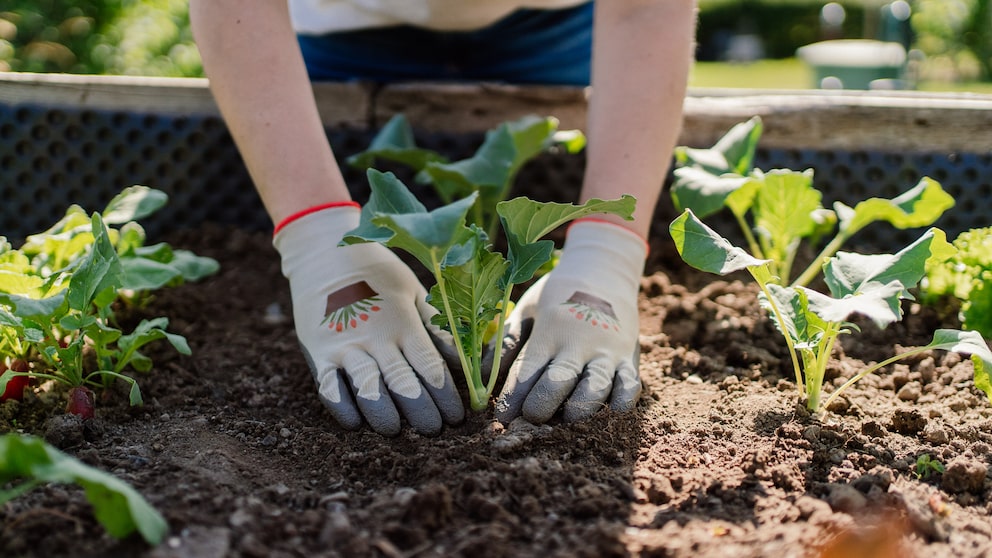April 11, 2025, 2:24 pm | Read time: 5 minutes
Temperatures are rising, and with them, the desire for lettuce, tomatoes, or cucumbers from your own garden. Raised beds are particularly popular for this. But when does the raised bed season actually start?
Made from plastic, old wooden pallets, self-built, or ready-made wooden parts: There are a whole range of ways to build a raised bed in your own garden. Regardless of how it is ultimately built, raised beds offer a number of advantages over ground-level planting. For example, raised beds generally warm up more quickly due to the rotting heat of the lower raised bed layers, and young plants can be moved to the open ground earlier in the year or sown directly there. In addition, slugs and other pests are less likely to climb the raised bed wall and are more likely to leave lettuce and other sensitive vegetables alone than in beds on the ground. But is there a rule of thumb for when you can start planting in raised beds?
Overview
When Can You Start Planting Raised Beds?
Basically (as is almost always the case), it depends on the plant. There are, of course, vegetable and fruit varieties that can tolerate lower temperatures and those that need more protection from cold snaps. The general weather conditions also determine the planting start in the raised bed.
Cold Frame Phase (from March/April)
With a cover, almost any raised bed can be transformed into a cold frame. Some manufacturers offer custom-fit glass tops that can also be opened up for ventilation. However, if in doubt, a small foil tunnel will also do.
It is important that this has ventilation holes to release excess heat and moisture. In such a protected environment, cold-resistant plants such as radishes, lettuce, and spinach can thrive from March onwards. Spring onions and kohlrabi are also ready to harvest early in the year in a cold frame raised bed.
Summer Vegetables (from mid-May)
If you grow tomatoes, zucchinis, peppers, eggplants, and basil on the windowsill in April, you can plant them in raised beds from around mid-May. After the Ice Saints, no more frosts are expected that could harm the Mediterranean plants. If you have a cold frame, you can also sow these plants directly under the protective cover at the end of April. Depending on the weather, however, a sudden frost can still damage the young plants.
Autumn and Winter Vegetables (from the end of August)
The raised bed season is far from over at the end of summer. Autumn and winter vegetables can now move in. Corn salad, spinach, and Swiss chard are germinating now and can be harvested well into the winter. Kale and Brussels sprouts can also be sown now, and winter vegetables can be provided from your own garden until the following spring.
Structure of the Layers in a Raised Bed
Raised beds consist of different layers with different materials. On the one hand, these should ensure good aeration and drainage, such as the bottom layer of old wood and branches. Finer layers of leaf litter and compost are often applied on top, and the top layer should consist of mature compost or a layer of vegetable soil.
When Is the Best Time to Build a Raised Bed?
Ideally, the raised bed should be installed in the fall. This is usually when a lot of organic material accumulates in the garden anyway. The raised bed can settle by the following spring, and some of the components will have decomposed.
It is also possible to rebuild it in spring, but amateur gardeners should wait at least two weeks before finally planting the raised bed. This is because the materials in the raised bed also need to settle in spring, and it may also be necessary to top up the soil.

Winterize the Vegetable Patch Now

4 reasons to create a raised bed in the fall

Planting and care tips for radishes in the garden
Conclusion: A Raised Bed Can Be Planted Almost All Year Round
From a cold frame with a protective cover to winter vegetables — with the right materials and approach, a raised bed can be used all year round. Between the winter vegetables and the cold frame in March, however, there should be a phase in which new humus or mature compost is applied to allow it to settle a little.
The soil in the raised bed generally does not need to be replaced, as it continues to be enriched with new nutrients year after year. By rotating plant species that require different nutrients or even planting those that contribute nutrients through nitrogen fixation at the roots (like lupines), you can ensure a long-lasting and productive raised bed.

